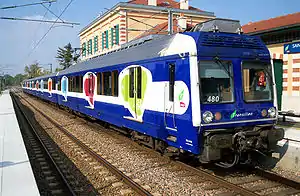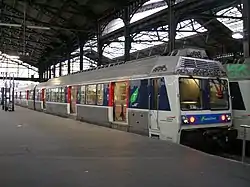| SNCF Class Z 6400 | |
|---|---|
 A refurbished Z6400 EMU in the "Grande Ceinture Ouest" version at Saint-Germain-en-Laye | |
| In service | 1976–2020 |
| Manufacturer | Alsthom/Carel et Fouché |
| Constructed | 1976–1979 |
| Refurbished | 1999–2005 |
| Scrapped | 2018–2021 |
| Number built | 75 4-car units |
| Number in service | 0 (as of 2021) |
| Formation | 4 cars per trainset |
| Operators | SNCF |
| Specifications | |
| Train length | 92.430 m (303 ft 2+31⁄32 in) |
| Car length | 15.60 m (51 ft 2+3⁄16 in) driving trailers, 15.79 m (51 ft 9+21⁄32 in) middle cars |
| Width | 2.95 m (9 ft 8+5⁄32 in) |
| Height | 4.295 m (14 ft 1+3⁄32 in) |
| Doors | 3 pairs per side |
| Wheel diameter | 800 mm (31.50 in) |
| Maximum speed | 120 km/h (75 mph) |
| Traction motors | 8 |
| Power output | 2,360 kW (3,160 hp) |
| Electric system(s) | Overhead line, 25 kV 50 Hz AC |
| Current collector(s) | Pantograph |
| Track gauge | 1,435 mm (4 ft 8+1⁄2 in) standard gauge |
The SNCF Class Z 6400 electric multiple unit trains were built by Alsthom/Carel et Fouché from 1976 to 1979. They are chiefly used in commuter service to the Gare Saint-Lazare in Paris, serving the northwest Paris suburbs.
Seventy-five of these 4-car units built for use on suburban service in the west of Paris, operating mainly on the Transilien Line L. The 4-car units are most often used in double-formation as 8-car sets. 43 sets have doors arranged for high platforms, while the remainder are for low platforms.[1][2]
They are being replaced by the Class Z 50000 units with complete withdrawal expected by 2021.[3][1]

A refurbished Z6400 EMU in the normal version at Paris-St-Lazare.
 A refurbished set seen heading for Paris-St-Lazare from St Nom la Breteche.
A refurbished set seen heading for Paris-St-Lazare from St Nom la Breteche.
See also
- CPTM (São Paulo commuter rail) operates a partially-forked version of the Z 6400 called CPTM 5000/5400 series (pt), manufactured by the Cobrasma–Francorail consortium in the late-1970s for the then-FEPASA – Ferrovia Paulista S/A on what is now CPTM Line 8
References
- 1 2 Haydock, David (2016). French Railways: Locomotives and Multiple Units (6 ed.). Platform 5. pp. 107–108. ISBN 978-1-909431-34-8.
- ↑ Redoutey, Denis (2016). Le Matérial Moteur SNCF en 2016 (7 ed.). Éditions La Vie du Rail. pp. 118–119. ISBN 978-2-37062-040-8.
- ↑ "Où sont les nouveaux trains ?". 19 January 2018.
This article is issued from Wikipedia. The text is licensed under Creative Commons - Attribution - Sharealike. Additional terms may apply for the media files.